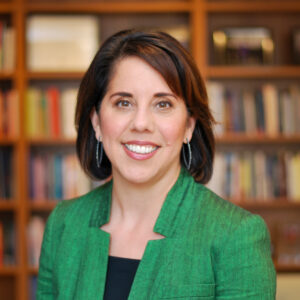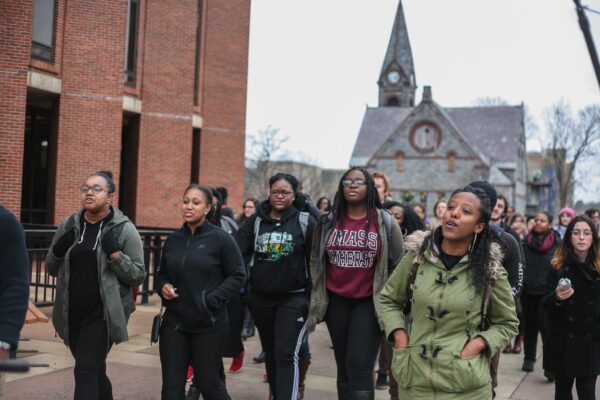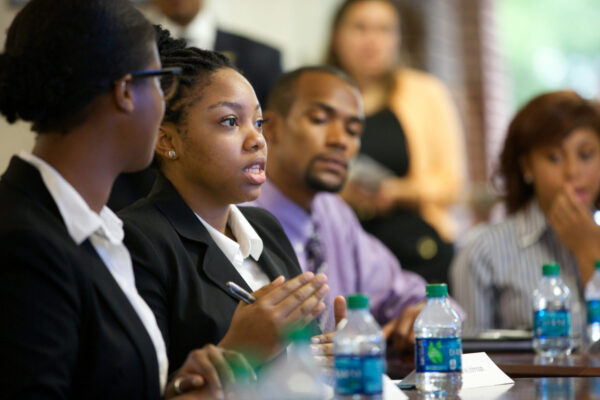By Lorelle L. Espinosa, Jennifer R. Crandall, and Philip Wilkinson
ACE recently surveyed nearly 500 college and university presidents to get their take on the state of free speech and inclusion on campuses today, as a companion to the new Knight-Gallup survey on student attitudes toward the First Amendment. You can read our comparison of the two surveys here.
Managing the tensions between campus inclusion and free expression is one of today’s most pressing challenges for college and university leadership. These tensions have been muddied in recent years by political polarization and high-profile incidents on select university campuses, making it convenient to put each of these two ideals—inclusion and expression—into their own boxes and talk about them as separate paradigms. The fact is, however, that they are far more mutually reinforcing than disconnected.
ACE’s Center for Policy Research and Strategy fielded its second national Pulse Point survey of college and university presidents in February to better understand leaders’ viewpoints and experiences on the timely issues of campus inclusion and freedom of expression. We received responses from 471 college and university presidents, the majority of whom lead four-year institutions—where the tensions are most visible and salient.*
Here’s what we found.
Democratic Values on Campus
Nearly all presidents indicated that promoting an inclusive society (98 percent) and protecting freedom of speech (98 percent) are extremely or very important to our democracy, reinforcing the understanding that these two concepts are not mutually exclusive.
[Click each image to view and download hi-resolution versions]
Similarly, almost all presidents at both public and private institutions agree on the role of higher education in protecting free speech. An overwhelming 96 percent said it is more important for colleges to allow students to be exposed to all types of speech even if they may find it offensive or biased than to protect students by prohibiting offensive or biased speech.
Notably, presidents indicated that students, faculty, and staff/administrators at their college were better at seeking out and listening to differing viewpoints from their own, compared to these groups at other institutions. Of these groups, presidents see postsecondary staff and administrators as doing the best job across the board.
Perceived Relationship Between Campus Inclusion and Free Speech
There also appears to be a disconnect between perceptions of what may be happening in one’s backyard compared to what is happening on a broader scale. Almost 80 percent of presidents said that campus inclusion and free speech work well together on their own campus; however, only 13 percent believed there was a similar connection between the two at a national level.
When asked to predict how the relationship between campus inclusion and free speech will evolve, presidents seem more optimistic about this relationship on their own campus than nationally. The vast majority of two- and four-year presidents thought this relationship would either improve or remain the same on their campus.
On the other hand, almost half of two-year presidents and over one-third of four-year presidents thought the relationship between campus inclusion and free speech would worsen nationally.
In addition to the perception that the relationship between inclusion and speech may deteriorate, presidents also were concerned about violence and student safety when it comes to managing efforts between inclusion and free speech.
Student Voices on Campus
In terms of campus activity, although controversial speakers have been highly visible flashpoints—especially in the press—less than 10 percent of all presidents reported that students have held demonstrations or protests against such speakers on their campus. Instead, issues of diversity and inclusion appear to have driven student activism at rates similar to demonstrations concerning racial diversity in the 2015–16 academic year.
Presidents draw clear lines in defining what is acceptable for students choosing to express their views on campus. Respondents identified distributing pamphlets or literature on controversial issues and engaging in protests against speakers as the most acceptable forms of engagement. Using violence to stop a speech, protest, or rally was uniformly rejected, and 85 percent of presidents said that shouting down speakers or trying to prevent them from talking was never acceptable.
Preparing for and Managing Conflict
To set institutional policy on conflict between campus inclusion and free speech, presidents rely most heavily on their vice president of student affairs or dean of students, provost, and legal counsel.
When responding to active conflict between campus inclusion and free speech, presidents continue to lean on their vice president of student affairs or dean of students, and turn to their chief public affairs or communications officer and chief of campus police ahead of other senior staff.
However, for both scenarios—planning and responding—managing tensions between inclusion and expression is an all-hands-on-deck endeavor.
Slightly over half of presidents indicated they have the tools necessary to address conflict on campus between inclusion and free speech, although most presidents mentioned additional tools of value. These included case studies offering strategies and tools for balancing tensions between campus inclusion and free expression, legally vetted policies and responses to free speech incidents, and education and training for the campus community.
Regardless of the confidence in their toolkit for handling conflict between inclusion and free speech on campus, findings indicated that presidents employ concerted strategies to manage these tensions. The most frequently identified strategies have to do with communication between the institution and its stakeholders, and reviewing or establishing institutional policies.
Over three-quarters of all presidents said they use clear public statements that reinforce stated institutional values, open community forums that provide a space for dialogue on issues of speech and inclusion, and the monitoring of social media for potential causes for concern.
Almost two-thirds of presidents reported reviewing/establishing institutional policies related to time, place, and manner restrictions. Other prominent strategies include professional development for faculty and staff; meeting with student groups; and reviewing or establishing institutional policies related to campus crises, speech codes, or invited speakers.
Less than half of presidents used social media to dispel myths or educate students on the history and purpose of the First Amendment—two areas that seem ripe for exploration.
[Click to expand]
As we reflect on how First Amendment freedoms have played out on campuses and the national stage, we have learned that demonstrating inclusion and free expression as mutually reinforcing concepts requires collective responsibility. Higher education leaders in particular need to teach and model civil discourse and debate that includes the full range of individuals in our richly diverse democracy. In balancing the tension inherent in this mission, leaders are right to recognize how today’s generation, having grown up in the age of the Internet and with new understandings of community, differs from their own.
These data will be explored further as part of a larger project ACE is engaged in with support from the John S. and James L. Knight Foundation. A report due out this fall will share what we learned from a series of national convenings with campus leaders on how institutions are managing tensions between campus inclusion and free expression.
*Notes:
Of the 471 college and university presidents who responded to this survey, 78 percent are leaders of four-year institutions (40 percent public and 60 percent private) and 22 percent are leading two-year institutions (97 percent public and 3 percent private). Regarding institution size, around 36 percent of presidents lead institutions that enrolled less than 3,000 undergraduate and graduate students, about one-third lead institutions with total enrollments between 3,000 and 10,000 students, and 31 percent lead institutions with more than 10,000 students.
Where applicable, figure percentages might not total 100 due to rounding.
If you have any questions or comments about this blog post, please contact us.

















